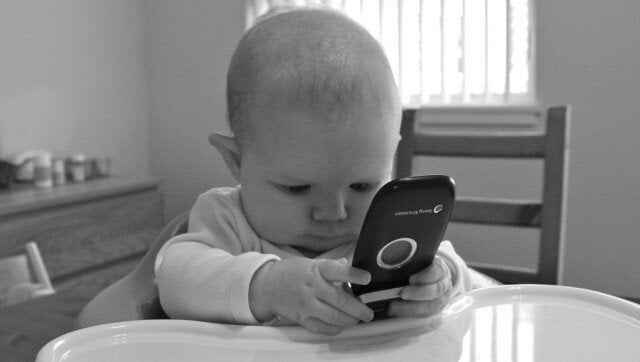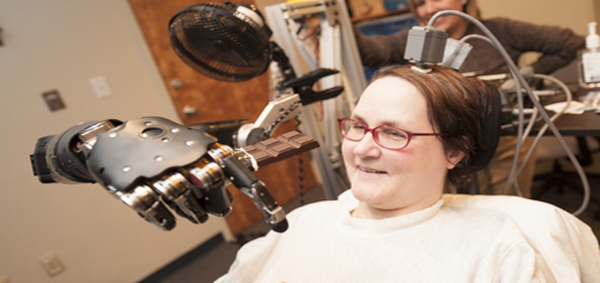
TED and The Huffington Post are excited to bring you TEDWeekends, a curated weekend program that introduces a powerful "idea worth spreading" every Friday, anchored in an exceptional TEDTalk. This week's TEDTalk is accompanied by an original blog post introducing the video, along with new op-eds, thoughts and responses from the HuffPost community. Watch the talk above, read the blog post and tell us your thoughts below. Become part of the conversation!
The term "cybernetic organism," or "cyborg" for short, conjures up a futuristic world of science fiction. Perhaps because this was how the term was introduced when sci-fi writers Manfred Clynes and Nathan Kline coined it in 1960 to mean a being composed of both biological and artificial parts. But to Amber Case, the transition of humans to cyborgs is here and now. Just look around. Amber sees our culture holistically and asks to what extent the technology that we carry in our pockets has evolved, and more importantly, how we, as humans, are evolving because of it. Watch her TEDTalk above to dive into cyborg anthropology and what it means to care for our "second selves" online.
Can these devices that alienate those around us, actually make us more human? Amber argues that our phones are wormholes in our pocket, connecting us in a practical and efficient way with loved ones. - Greg Gage
For several decades, the field of biomedical engineering has developed and deployed cyborg technologies fervently to help us restore lost human functions. Deep Brain Stimulation electrodes are used to restore natural movements, cochlear implants can help restore hearing, and brain machine interfaces can be used to bring back vision or motor functions. Earlier this month, Andy Schwartz and his team at the University of Pittsburgh published a paper in the Lancet about Jan Scheuermann, a quadriplegic woman, who used a brain-machine interface to reach, grasp, and feed herself with the assistance of robotic arm driven from neurons recorded from 96 electrodes in her motor cortex.

Photo by permission of UPMC.
It is clear that these advances in medical technologies fit the definition of a cyborg. Even beyond the medical field, our organization now sells living cyborgs (half cockroach/half machine) to teach school kids and the public about neuroprosthetic devices. But can the cyborg definition of "a symbiotic fusion of human and machine", be broadly applied to all of us?
The march of personal electronics has continued unabated for the past 50 years, with 2012 ushering in new phones and tablets from Microsoft to compete with ubiquitous smart devices from Apple and Android. One needn't look much further than the person across from you on the metro or cafe to see the impact these devices have on the way we communicate with each other. We consult our devices at all times. Not just for directions, but also socially, during family gatherings, meet-ups with friends, even on dates.
Amber's talk makes us think more carefully about our "second selves" on Facebook and other social sites. The point is our "second self" stays online even when we are not there. And this raises the unusual question of how living this dual life impacts our ability to self-reflect and engage in real life situations.
Can these devices that alienate those around us, actually make us more human? Amber argues that our phones are wormholes in our pocket, connecting us in a practical and efficient way with loved ones. But the idea of digital or "ambient intimacy" -- that we use Facebook, Instagram, and Twitter as a way to feel closer to people whom we care for, but are unable to participate as closely as we'd like to in real life -- is the last thing some of us want. In fact, the debate of virtual communities and relationships remains hotly contested, even polarizing in families. Perhaps we aren't all cyborgs yet.
Pause and think of where technology will go in the near future, and how this will shape our interactions with each other. Three states have now passed laws permitting driverless cars (being developed and tested by Google). How will this change the way we work, and how we spend time with others on the road? Will we drive more now that we are more productive? Will we consult new location services for information about who is around us to determine where to go or where to avoid? Will Siri and other voice-based services create a more human-like interaction with devices that change our perceptions of technology? As our life and our devices becomes more integrated, I can see Amber's prediction coming true. So the next time you have that feeling that a part of you is missing when you forget your phone at home... at least you will know why.
Ideas are not set in stone. When exposed to thoughtful people, they morph and adapt into their most potent form. TEDWeekends will highlight some of today's most intriguing ideas and allow them to develop in real time through your voice! Tweet #TEDWeekends to share your perspective or email tedweekends@huffingtonpost.com to learn about future weekend's ideas to contribute as a writer.